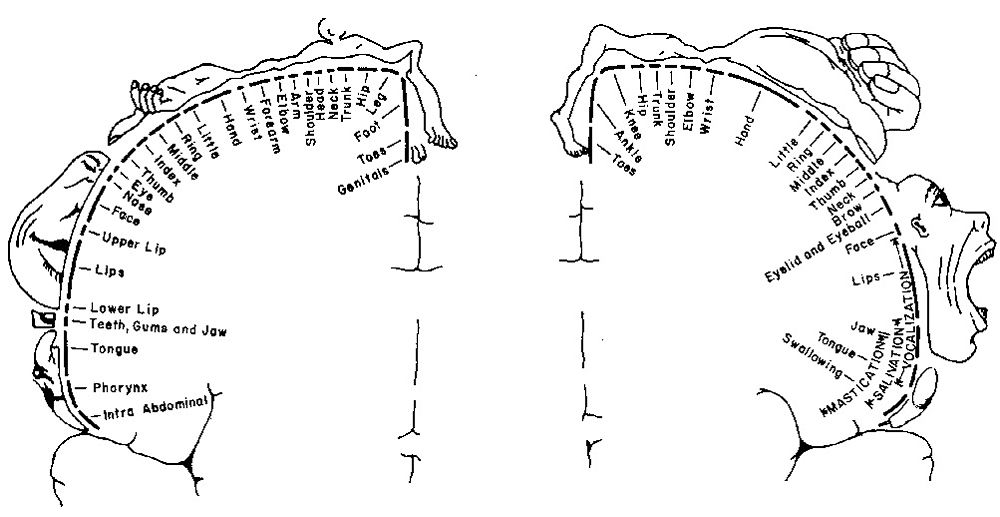
|
Lorna Mills and Sally McKay
Digital Media Tree this blog's archive OVVLvverk Lorna Mills: Artworks / Persona Volare / contact Sally McKay: GIFS / cv and contact |
View current page
...more recent posts

This is the famous brain map of sensory input by Dr. Wilder Penfield called the "homunculus." Wikipedia warns us that it's not necessarily totally accurate, and may be out of date. But in general it illustrates that our body parts are mapped on the cortex of the brain. But the brain doesn't just map our body, it also maps the area around us. Sandra Blakeslee is a science writer who co-authored Phantoms in the Brain with VS Ramachandran and recently wrote all about brain mapping with her son Matt, in a book called The Body Has a Mind of It's Own. On the Brain Science Podcast she described how she got the idea for the book while browsing the posters at a big neuroscience conference.
There was a paper by an Italian neuroscientist that talked about perispersonal space, which I had never heard of. So I went over and starting asking him, and we were talking about strokes and this method he had of studying strokes. And then I said to him, "What's peripersonal space?" And he — it's so cute — he stepped back and took a pen and he said, "You see this pen? It is now outside of your peripersonal space." And then he went dvvvf, dvvvf, dvvvf and started moving it closer and closer to me. And then he got it into the area around me. If you put your arms out over your head, and to your side and down by your hips, that's your peripsersonal space. And he was telling me that that space is actually mapped in your parietal lobe. I couldn't believe it. I knew that the brain maps the body, I knew about the Penfield maps and the classic touch maps and motor maps, but the idea that the space was mapped... And when you use tools the maps increase in size. ... It was just enchanting. And then a bunch more findings were coming along at that time about tool use, and mapping, and about mirror neurons which are about mapping your social world. And then this whole thing about inner reception, which is how you map the internal feelings in your body... this was so exciting...Later in the interview she explains how this mapping of the perispersonal space can account for why we are aware that there is somebody behind us, etc. She also describes how out of body experiences can be induced with elecrtrode stimulation in the right angular gyrus, and how seeing auras can result from synaesthesia. And she says this rather sweet thing...
Some people when they are very young start seeing coloured auras around others. They're not making it up, they really do see that. And in fact people that have those kinds of really strange synaesthesia think it's perfectly normal. They reach their late teens before they realise that not everybody sees the world that way. Out of body experiences, near death experiences, healing touch — we're proposling neurophysiological explanations for a lot of these phenomena that are routinely described as the paranormal. And no wonder! I mean, if you have an out of body experience it's real, you're not making it up. And then modern science comes along and says "Oh, no no no, that can't be." So people are drawn to the parapsychology world for the lack of an explanation from the more allopathic scientific world.